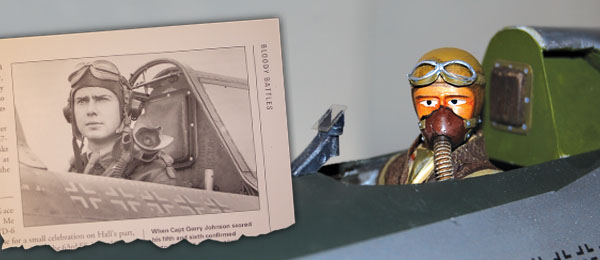
Article and photos by the author. Featured in the Spring 2011 issue of Park Pilot.
I really needed a full-figure pilot for my new de Havilland D.H.2. The model’s bare cockpit was like a gaping hole in the nacelle that exposed some of the radio gear and the battery tray. In one of my previous articles for Park Pilot, I had outlined a step-by-step for painting a pilot figure. Now I will demonstrate how you can transform a commercially available pilot bust into a 3/4-size or full-figure pilot. I found a nice 1/8-scale pilot bust from Maxford USA. The bust looked as though it would fit into my model, but I felt that it would look a bit silly to simply glue the bust onto a stick and install it in the cockpit as it was. I knew that I had to add the rest of the torso, most of the legs, and the arms and hands to complete the illusion of having a real pilot in the cockpit. My plan was to leave off the lower legs since the battery tray would interfere with them. In the real D.H.2, the pilot’s legs fit way up front in the nose, under the instrument panel, so the omission was no big deal. I also had to make the figure removable for access to the RC gear, and use the torso to house my receiver. No seat would be necessary since the real D.H.2’s seat was very small, and no part of it would have been visible with the pilot sitting on top of it.

Here are the basic components that Rob Caso uses to create a full-figure pilot. (Left) Blue foam is cut and sanded to mate with the commercially available Maxford USA pilot bust. (Right) The foam body parts are shown here, already attached to the bust with epoxy and blended in.

Rob uses a piece of card stock as a template to help fashion his pilot’s arms.

Each arm is sanded round, glued to the bust with epoxy and faired into the bust.
I started with the Maxford bust and some blue-foam sheet. I measured myself to get the proportions close to correct, then cut the basic shapes from the foam. Note that the science of human measurement is called “anthropometry,” and professional sculptors proportion everything from the dimensions of the head. After hogging out the inside of the bust to save weight and make room for the receiver, assembly began with my use of epoxy to attach the newly cut foam torso to the bust with epoxy. I rough-shaped the torso, then coated the bare foam with Minwax Polycrylic. This coating allows vinyl spackle to adhere better, and prevents primers from attacking the foam. I coated the torso with spackle and sanded it, then attached and spackled the roughly shaped legs. I brushed more Polycrylic over the spackled areas, then applied very light coats of auto-body primer. Primer highlights where you need to contour the additions, and it reveals all your mistakes. I cut a piece of card stock to profile the arms, which helped me get the proper dimensions and angles. Once cut, I rounded the arms before pinning them onto the torso. At that point, I had to decide whether to attach the arms and finish them in place or work on them while they were still unattached to the torso. I chose the former because of access, and it would be easier to blend the upper arms into the pilot’s shoulders. The pilot’s new flight suit had to blend in with jacket on the bust. Once I had the contours right, I began to build up the continuations in creases, folds and seams. The hands are hardest to get right. They must be in proportion to the rest of the figure, and posed correctly to hold the control column or work the other controls. My pilot wears heavy gloves, which makes this process a bit easier.

(Left) The pilot’s hands are fashioned from an armature of copper wire, then filled with auto-body putty and sanded. (Right) Once the hands are attached, filler is used to create gauntlet gloves.

Open the ends of the forearms with a rotary tool to fit the hands.
I made an “armature,” a common practice in sculpting circles. Wire strands, soft enough to bend but stiff enough to hold their shape, are formed in the rough shape of the arms, then filled with putty, trimmed and sanded. I also used body filler to create the gauntlets, and to blend the hands in with the forearms. The arms are foam and somewhat on the weak side, so I used a 3/32-inch drill to cut a path for a couple of toothpicks that would give the arms rigidity. Inserted with epoxy, one goes up from the elbow to the shoulder and the other goes in from the back of the elbow. After final filling and detailing my additions, I used the painting process that I’ve outlined in previous articles. Now, when a commercially available, full-figure pilot is not available, you know how to make one. It’s considerable work, but sensible for a serious scale model.

Here’s the pilot, finished in primer. His face has already been painted with a flesh tone mix.

All the painting and detailing has been completed, and the pilot is in the cockpit.
Article:





